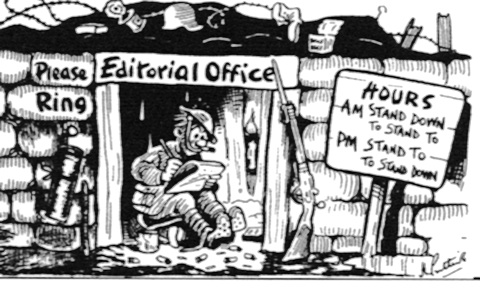John William Wheway - 1897
-1974
John William Wheway was born in 1897 in a back street of Walsall, West Midlands, the only child of a silver plater. His primary education at Chuckery School was sparse owing to repeated illness but he had a vivid imagination and loved relating stories to friends and family. In the early 1900ʻs reading matter was hard to come by for poor families and the printed word had young John devouring as much as he possibly could. By the age of 8 he knew he wanted to become an author and so he started writing but, since paper was scarce, he had to scavenge for it and, as a boy, wrote many short stories on margarine wrappers with pencil stubs and anything that would write.
In 1909 he moved to London and went to Christ Church School in Southwark where he was ʻcontrollerʼ, ʻcontributorʼ and ʻproducerʼ (his words) of his school magazine - The Young Idea. His headmaster, undoubtedly impressed with Johnʼs flair for writing and layout and design (he won an award at St. Brideʼs Institute) found John a job as apprentice at The Amalgamated Press in the Composing department. In due course he became a fully fledged compositor. During his apprenticeship he revived a publication called The Reading Boys Journal.
Eager to join up at the age of 17, the First World War took John into the trenches in France where he went ʻover the topʻ (leaving the trenches and going to battle) numerous times and was a survivor of the Battle of the Somme.
It was in the trenches that John conceived of the Whizzbang Press and his first saleable publication, The Periodical Recorder. Publication was delayed by the battle of Messines Ridge (one of the craters created by the blasts at this battle is 250 feet wide and 40 feet deep. It still exists today). Afterwards, the first edition was printed. But the printing press and the proofs of of the Periodical Recorder were lost in battle. Undeterred, Jon launched another journal called Cheerio and followed it with another publication, the Dug-Out Daily.
When the war was over, John ran his own printing company, The Selway Press. By now he was writing for the the Gem, the Magnet, and Boy's Friend under his own name and the pen name Vincent Armitage.
At this time, John joined a theatrical company in London's Strand (he loved acting and was an excellent quick-change artist) -there he was befriended by George Bernard Shaw who was always keen to help up-and-coming young people from poor backgrounds. GBSʼs influence and encouragement helped John become proud of his working-class heritage and he became involved with the Fabian Society and the trade Union movement.
He wrote at least half a million words a year and was known amongst his peers as one of the most prolific authors of children's fiction. He could turn out at least 10,000 words at a single sitting. As one of the original staff on Champion he combined writing and the sub-editorship of Pluck with this job. He also wrote for the Union Jack, Boy's Friend Weekly, Gem, Boy's Friend Library, Boy's Realm, Chums, Champion, Triumph and BoysWonder Library.
It was during the 1920ʻs that John found his niche in girlsʼ fiction. Even though he continued to write for both girls and boys, John is best known for his work as author of stories of Cliff House School and for Bessie Bunter, Billy Bunter's sister. The pen-name Hilda Richards, was initially Charles Hamilton's, but he signed over all rights to the Amalgamated press. John turned Bessie into a ʻlovable dufferʼ and the Cliff House stories became a huge success for School Friend. Because of his amazing output of words, John not only had the pen name Hilda Richards but he was also Hazel Armitage, Anne Gilmore, Gladys Cotterill, Wynne Chester, Diana Martin, Heather Granger, Audrey Nicholls, Gail Weston and many others. His love of printing never left him and not only did he write at least 50,000 words a week throughout his career, he was also writing, editing and designing a magazine for the Adana Printing works, Printcraft.
Up to his death in 1974 John continued to write. His stories about Lynette, a French Resistance worker, were very popular here and widely read and much enjoyed in France.
The man who made a living from writing but never had huge financial success, considered himself to be a ʻprofessional fiction writerʼ. His genre was mainly the written word. “Written description can stir the imagination and touch the soul deeply in a way that picture stories never can,” he often said.

